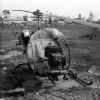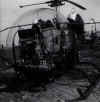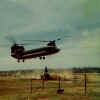




by R. Wingate
TIPTOE THROUGH THE MINEFIELD
To set the scene for this story, a particular operational procedure should be understood. When the unit moved north to the Quang Tri area, two main LZ's were established. The main group was located at LZ Sharon, while the Headquarters group with its aviation section set up camp near by at LZ Betty. This location had been occupied by various forces over the years, and at one time had been a French fort. Between the main compound and the open area which was used as the helipad for the camp was an earthen berm, a moat, and a minefield. While the helicopters belonging to the Flying Circus were parked in the outer area during the day, they were moved into the "fort" for the night. The C&C helicopters were parked inside the main compound and the scout machines were parked in a series of revetments located between the buildings and the berm. Now the fun begins!
(See overhead photo in HISTORY / A PLACE TO HANG OUR HAT / QUANG TRI - LZ Betty, and OH-13's in revetments in PHOTO ALBUMS / 1968-A / OVERNIGHT PARKING)
Each morning, the scout helicopters were flown out of their revetment, over the berm, the moat, and the minefield, to the parking area. In the evening, this process was reversed. Some pilots flew over the buildings and then made a vertical descent into the revetments, while most hovered back over the obstacles and then made a 180 degree turn before descending into the revetment. This was a process that would surely be approved by any modern day civilian aviation authority officer.
On the particular day in question, GAUCHO was preparing to move an OH-13 into the overnight parking area. During the run-up checks, there was a 50 rpm drop on one of the mags. GAUCHO elected not to bring the helicopter into the compound in this condition, so the Maintenance Officer was summoned to the scene. Ronnie Robinette did some further checks on the engine, after which a disagreement was reached concerning how to get the helicopter into the compound for the night. Though the process of hooking up the ground handling wheels and towbar to the machine was a simple matter in itself, the movement into the compound was complicated by a low arch at the entrance which would involve some interesting gyrations to navigate. To complicate matters further, night was falling.
Robinette decided that the problem was not too bad, so he elected to fly the helicopter into the compound. GAUCHO recalls that as he stood by while the aircraft was run up, picked up and turned for the movement toward the revetments, the engine sounded pretty good. As the helicopter reached the critical point where it was committed to cross the minefield, the engine began to lose power. It was later discovered that the valve door that opens to let pressurized air into the engine from the supercharger had closed which meant that the engine would not run much above idle - but knowing this fact would not have helped Robinette at that point. The helicopter settled into the minefield, coming to rest against a fence post which broke the bubble. After convincing himself that nothing had exploded, and realizing that the engine was still running, he tried to get enough power from it to lift the machine out of the minefield; but the engine would do no more than idle.
One of the door gunners drove a jeep out to the scene and up against the fence line, which put it near the end of the skids. After shutting everything off in the helicopter, Robinette climbed out along the skid and onto the front of the jeep. Murphy and his laws was not through with CHEROKEE though, as he pulled a trip wire and set off a flare as he was negotiating this perilous route. This did nothing for his disposition at the time!
The story does not end there, because the helicopter still had to be removed from the minefield. Extra security guards and some spotlights were organized for the helicopter, and it spent at least that night where it came to rest. Since the minefield had been owned by the French, the Vietnamese, the U.S. Marines, and then finally the 1st Cav, an accurate map of the site was virtually out of the question.
After the mine detecting team finished clearing the area around the helicopter, a CH-47 Chinook was brought in to lift it over the fence. Phil Bishop hooked up the sling, but then his troubles began. Various accounts of what happened next have the hook aircraft settling down toward him and the OH-13 spinning around as it was lifted. In either case, or a combination of both, Bishop had to dive off of the scout bird. His roll on the ground carried him slightly outside the white tape marking the safe area that had been checked for mines, though he did manage to avoid the piles of mines already dug up. There was one more serious drinker at the bar that night.
details submitted by W. Sullivan (GAUCHO), R. Robinette (CHEROKEE), and others
compiled by F. Vanatta
 |
 |
 |
 |
 |
| by GAUCHO | by R. Robinette | by P. Bishop | R. Robinette
by R. Wingate |
by P. Bishop |